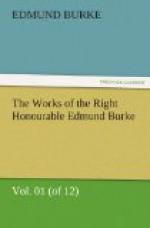SECTION IX.
SUCCESSION AND UNIFORMITY.
Succession and uniformity of parts are what constitute the artificial infinite. 1. Succession; which is requisite that the parts may be continued so long and in such a direction, as by their frequent impulses on the sense to impress the imagination with an idea of their progress beyond their actual limits. 2. Uniformity; because, if the figures of the parts should be changed, the imagination at every change finds a check; you are presented at every alteration with the termination of one idea, and the beginning of another; by which means it becomes impossible to continue that uninterrupted progression, which alone can stamp on bounded objects the character of infinity. It is in this kind of artificial infinity, I believe, we ought to look for the cause why a rotund has such a noble effect.[20] For in a rotund, whether it be a building or a plantation, you can nowhere fix a boundary; turn which way you will, the same object still seems to continue, and the imagination has no rest. But the parts must be uniform, as well as circularly disposed, to give this figure its full force; because any difference, whether it be in the disposition, or in the figure, or even in the color of the parts, is highly prejudicial to the idea of infinity, which every change must check and interrupt, at every alteration commencing a new series. On the same principles of succession and uniformity, the grand appearance of the ancient heathen temples, which were generally oblong forms, with a range of uniform pillars on every side, will be easily accounted for. From the same cause also may be derived the grand effect of the aisles in many of our own old cathedrals. The form of a cross used in some churches seems to me not so eligible as the parallelogram of the ancients; at least, I imagine it is not so proper for the outside. For, supposing the arms of the cross every way equal, if you stand in a direction parallel to any of the side walls, or colonnades, instead of a deception that makes the building more extended than it is, you are cut off from a considerable part (two thirds) of its actual length; and, to prevent all possibility of progression, the arms of the cross taking a new direction, make a right angle with the beam, and thereby wholly turn the imagination from the repetition of the former idea. Or suppose




